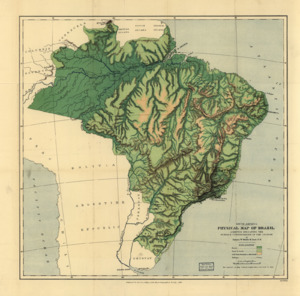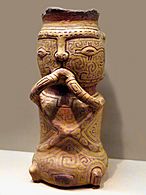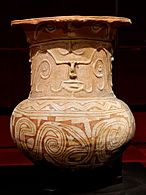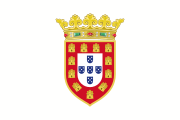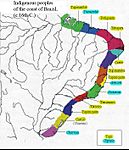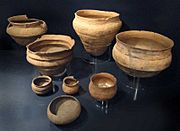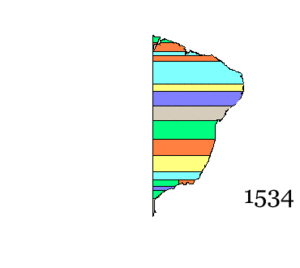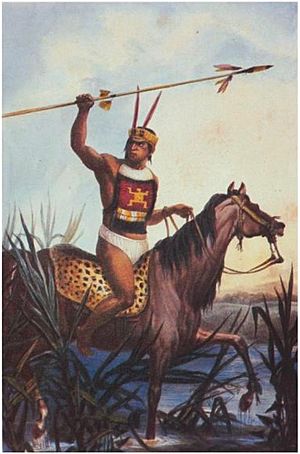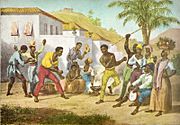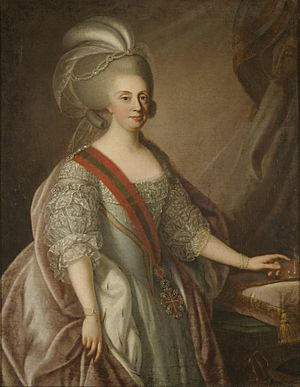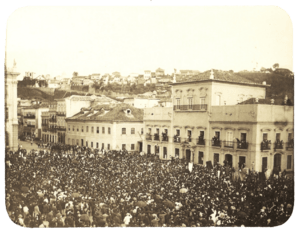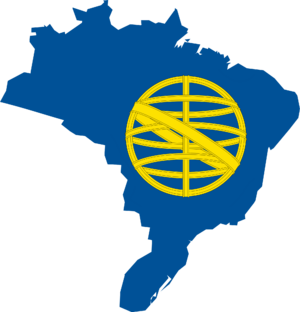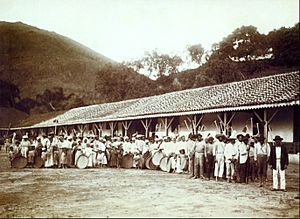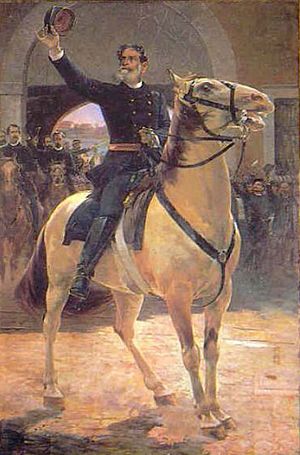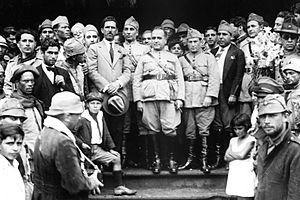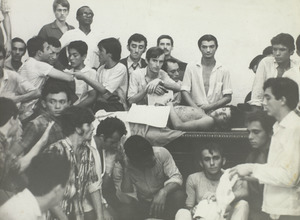History of Brazil facts for kids
The history of Brazil began long before Europeans arrived, with many different native tribes living across the land. These groups had their own cultures and ways of life. On April 22, 1500, Portuguese explorers led by Pedro Álvares Cabral reached the coast of what is now Brazil. They were on their way to India, supported by the Kingdom of Portugal and the Catholic Church.
From the 1500s to the early 1800s, Brazil grew as a colony and then a kingdom, becoming an important part of the Portuguese Empire. The land was first called "Land of the Holy Cross." Later, it was named "Land of Brazil" because of the valuable Brazilwood tree, which produced a red dye. Brazil expanded its territory, moving south along the coast and west along rivers like the Amazon. Its borders were set in the early 1900s, making it the largest continuous country in the Americas.
On September 7, 1822, Brazil declared its independence from Portugal. It became the Empire of Brazil, led by an emperor. In 1889, after a military takeover, Brazil became a democratic republic. Later, from 1964 to 1985, a military government ruled the country. After that, democracy returned. Brazil is now a democratic federal republic.
Brazil has a rich culture and history. It has many UNESCO World Heritage Sites, ranking thirteenth in the world. Brazil is also a founding member of several important international groups. These include the Community of Portuguese Language Countries, Mercosul, the United Nations, the G20, BRICS, and the Organization of American States.
Contents
Ancient History of Brazil
Long before Europeans arrived, people lived in Brazil. Some of the oldest human remains in the Americas, like Luzia Woman, were found in Minas Gerais. This shows that people lived there at least 11,000 years ago.
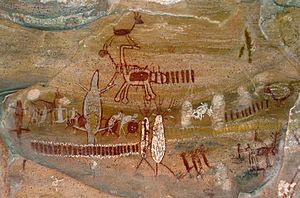
When Portuguese explorers came in 1500, hundreds of different native tribes lived in Brazil. Many of these tribes spoke languages from the same Tupi–Guarani family. They were mostly semi-nomadic, meaning they moved around. They hunted, fished, gathered food, and farmed. Most natives lived along the coast and major rivers.
Archaeologists found the oldest pottery in the Western Hemisphere in the Amazon basin of Brazil. It is 8,000 years old. This discovery changed ideas about ancient cultures in tropical forests. Most experts believe the first tribes came to the Americas from Asia. They likely crossed the Bering Strait or traveled along the Pacific coast.
The Andes mountains separated the settled farming civilizations in the west from the semi-nomadic tribes in the east. Because of this, we know little about Brazil's history before 1500. Archaeological finds, like pottery, show that different cultures developed and moved around. Some even formed large groups.
European diseases spread quickly among the native people. Many tribes had no protection against these illnesses. This caused many native groups to disappear, even before meeting Europeans directly.
Marajoara Culture on Marajó Island
The Marajoara culture thrived on Marajó Island, located at the mouth of the Amazon River. Archaeologists have found amazing pottery from this culture. These pieces are large, beautifully painted, and show designs of plants and animals. This pottery was the first sign that a complex society lived on Marajó Island.
|
|
|
The Marajoara people also built large mounds. This suggests that they had well-populated and organized settlements. Only complex societies could manage such big construction projects.
Some researchers thought this society came from the Andes mountains. However, archaeologist Anna Curtenius Roosevelt's work in the 1980s showed that the Marajoara culture likely developed on the island itself.
This ancient culture might have had different social classes. It could have supported as many as 100,000 people. The native people of the Amazon rainforest may have used a special method called Terra preta to make the land fertile. This allowed them to grow enough food for large populations and complex societies.
Early Colonial Brazil
In 1493, the Pope divided the "New World" between Spain and Portugal. The Treaty of Tordesillas in 1494 moved this dividing line further west. This treaty influenced who could claim lands in the Americas.
|
||||
Many people wonder who was the first European to reach Brazil. Some say it was Duarte Pacheco Pereira in 1498. Others believe it was Vicente Yáñez Pinzón in January 1500. However, Pinzón could not claim the land due to the Treaty of Tordesillas. In April 1500, Pedro Álvares Cabral officially claimed Brazil for Portugal.
The Portuguese found native people who used stone tools. These tribes often fought among themselves. Early names for Brazil included Santa Cruz (Holy Cross) and Terra dos Papagaios (Land of the Parrots). Later, the country was named after the pau-Brasil tree, or brazilwood. This tree produced a valuable red dye and was almost completely cut down.
For a while, Portugal was more interested in trade with India and China than in settling Brazil. This allowed traders and pirates from other countries, like France, to take brazilwood. France even tried to set up a colony called France Antarctique in 1555. To stop this, Portugal created a system of hereditary captaincies. Large areas of land were given to Portuguese noblemen. They were in charge of settling and managing the land for the King. Later, the government was split into two parts: a Northern Government in Salvador and a Southern Government in Rio de Janeiro.
Portuguese-Brazilian settlers brought many new things to Brazil. These included crops like rice, coffee, and sugar. They also brought animals like cows, chickens, and pigs. New skills like stonemasonry and metalworking were introduced. The Portuguese often married native and African people. This created a diverse population.
Iberian Union and Expansion
In 1578, the young King Sebastian, King of Portugal disappeared during a war in Morocco. He had no direct children to take his place. So, Philip II of Spain, who was his uncle, became the ruler of Portugal in 1580. This joining of the two crowns was called the Iberian Union and lasted for 60 years.
During the Iberian Union, Portuguese and Brazilian settlers were allowed to cross the Treaty of Tordesillas line. This led to more exploration and expansion into the interior of Brazil. In 1640, John IV of Portugal restored Portugal's independence. He started the third Portuguese Royal Dynasty, the House of Braganza.
Native Rebellions Against Portuguese Rule
One important rebellion was the Tamoyo Confederation. This was a military alliance of native chiefs along the coast, from what is now Santos to Rio de Janeiro. It lasted from 1554 to 1567.
The main reason for this alliance was to fight against the slavery and violence brought by the early Portuguese settlers. In the Tupi language, "Tamuya" means "elder." Cunhambebe was chosen as the chief of the Confederation. He and other chiefs declared war on the Portuguese.
The Sugar Age and Dutch Invasion
Starting in the 1500s, sugarcane became very important to Brazil's economy. It was grown on large farms called engenhos along the northeast coast. These farms used enslaved people to produce sugar for Europe. At first, settlers tried to enslave native people. But soon, they began importing millions of slaves from Africa.
Portugal had already used this plantation system in its Atlantic islands. By 1570, Brazil's sugar production was huge. In the mid-1600s, the Dutch took over sugar-producing areas in northeast Brazil from 1630 to 1654. When the Dutch were forced out by Portuguese-Brazilians and their allies, they started sugar production in the Caribbean. This increased competition and lowered sugar prices, affecting Brazil's market share.
Brazil's recovery from the Dutch invasion was slow. Warfare had damaged many sugar plantations. In Bahia, tobacco was grown and traded for African slaves. Brazil's economy and settlements were mostly along its long coastline. The Dutch invasion showed that Brazil was vulnerable. So, the Portuguese built coastal forts and created a navy to protect the colony.
Exploration of Brazil's interior was often done by adventurers called bandeirantes. They went into the jungle looking for gold and native slaves. However, it was hard to keep native people enslaved. So, Portuguese sugar planters turned to importing millions of slaves from Africa. Many enslaved people died quickly in sugar and gold mines. This meant there were often not enough women or good conditions for the slave population to grow naturally.
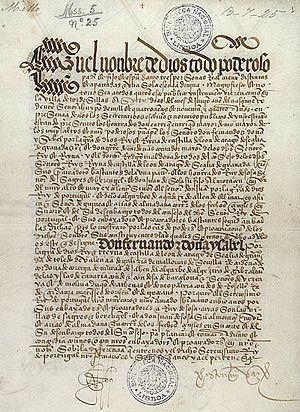
Still, Africans became a large part of Brazil's population. Over time, they mixed with the European Brazilian population. Other European powers tried to set up colonies in Brazil, ignoring the Pope's division of the New World. French colonists tried to settle in Rio de Janeiro (1555-1567) and São Luís (1612-1614). Jesuits arrived early and helped the Portuguese drive out the French. The Dutch also tried to establish a colony, which lasted longer (1630-1654). But after years of fighting, the Dutch left in 1654.
Slave Rebellions and Zumbi dos Palmares
|
|||
Rebellions by enslaved people happened often until slavery was ended in 1888. The most famous revolt was led by Zumbi dos Palmares. He established a self-governing community called Quilombo dos Palmares. This was a republic of Maroons, who were enslaved people who had escaped from Portuguese settlements. At its peak, Palmares had over 30,000 people.
The warriors of Palmares were skilled in capoeira. This is a martial art developed in Brazil by African slaves in the 16th century. They used it to defend themselves against repeated attacks by the Portuguese.
Zumbi was born free in Palmares in 1655. He was captured by the Portuguese at age 6 and given to a missionary. He learned Portuguese and Latin. But Zumbi escaped in 1670 and returned to Palmares at age 15. He became known for his strength and cleverness in battle. By his early twenties, he was a respected military leader.
In 1678, the governor of Pernambuco offered freedom to all runaway slaves if Palmares would submit to Portuguese rule. The leader, Ganga Zumba, liked this idea. But Zumbi did not trust the Portuguese. He refused to accept freedom for Palmares while other Africans remained enslaved. Zumbi became the new leader of Palmares, vowing to continue fighting.
Fifteen years later, in 1694, Portuguese forces attacked Palmares with cannons. On February 6, 1694, they destroyed Cerca do Macaco, the main settlement. Palmares fell, and Zumbi was wounded. He escaped but was betrayed and captured almost two years later. He was beheaded on November 20, 1695. The Portuguese displayed Zumbi's head in Recife. This was to show that he was not immortal, as some believed, and to warn others against rebellion.
The Gold and Diamond Rush
The discovery of gold in the early 1700s brought great excitement to Portugal. Its economy was struggling after years of wars. A gold rush quickly began. People from other parts of Brazil and Portugal rushed to the region. This area became known as Minas Gerais (General Mines). Gold mining became the main economic activity in colonial Brazil during the 18th century.
In Portugal, the gold was used to buy goods like textiles and weapons from other countries. It was also used to build beautiful Baroque monuments. In Brazil, the gold rush led to the growth of towns and cities. Many of these, like Ouro Preto, are now UNESCO World Heritage Sites. Ouro Preto was one of the largest and richest towns in the Americas during this time. Other historic towns with beautiful architecture include Paraty, Olinda, and Diamantina.
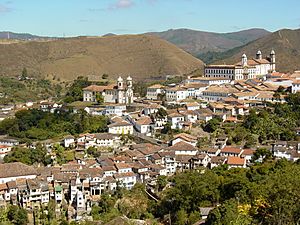
Minas Gerais was the center of gold mining. Enslaved labor was widely used. The discovery of gold brought many European immigrants. The Portuguese government sent officials to control the mining. However, these officials often struggled to manage the very profitable industry. After Brazil's independence, the British became involved in mining. In 1830, the Saint John d'El Rey Mining Company, controlled by the British, opened the largest gold mine in Latin America.
Diamond deposits were found near Vila do Príncipe in the 1720s. This led to a rush for diamonds, which flooded the European market. The Portuguese crown stepped in to control production in Diamantina, the Diamond District. They eventually took full control of the diamond trade in 1771.
Mining helped southern Brazil grow. It not only produced gold and diamonds but also boosted food production for local use. More importantly, it encouraged trade and the growth of merchant communities in port cities. Portugal tried to control trade with Brazil, but in reality, goods from other countries often passed through Portugal before reaching Brazil. Direct trade with foreign nations was forbidden. However, after the American Revolution, U.S. ships began visiting Brazilian ports. When the Portuguese royal family moved to Brazil in 1808 to escape Napoleon's wars, one of their first actions was to open Brazilian ports to foreign ships.
Kingdom and Empire of Brazil
Brazil was one of the few countries in the Americas to have a monarchy. It was ruled by emperors for almost 90 years.
In the late 1700s, as Haiti fought for independence from France, Brazil also had ideas of revolution. People in Brazil, including poor whites, freed people, enslaved people, and mixed-race natives, wanted to revolt. They aimed to end slavery, reduce the power of the Catholic Church, stop racial unfairness, and create a new government with equal chances for everyone.
Early plans for rebellion were stopped by the Portuguese authorities. But Brazilians kept trying, inspired by successful independence movements elsewhere. However, the harsh punishments for the lower classes made many afraid. Some wealthy whites were influenced by revolutionary ideas from France. But others saw the violence of the Haitian Revolution and feared a similar uprising in Brazil. It was not until September 7, 1822, that the Portuguese Prince Dom Pedro declared Brazil an independent empire.
In 1808, the Portuguese royal family fled from Napoleon's invasion of Portugal. They moved their government to Brazil, settling in Rio de Janeiro. The Portuguese king ruled his vast empire from Brazil for 15 years.
In 1815, the king made Brazil a united kingdom with Portugal. In 1817, a revolt happened in the province of Pernambuco, but it was quickly stopped.
When King João VI of Portugal returned to Portugal in 1821, his son, Pedro, stayed in Brazil as regent. A year later, Pedro declared Brazil's separation from Portugal. He led the Independence War and became Emperor Pedro I of Brazil. He later returned to Portugal to fight for a constitutional monarchy there. Brazil's independence was officially recognized in 1825.
Brazil's large territory was mostly formed before its independence in 1822. Rio de Janeiro was even the capital of the Portuguese Empire for 14 years.
Emperor Pedro I gave up his throne in 1831. He left Brazil to help his daughter become queen of Portugal. His five-year-old son, Pedro II, became the future Emperor. During Pedro II's childhood (1831-1840), the country was ruled by regents. This period saw many rebellions, like the Ragamuffin War and the Malê Revolt. After this time, Pedro II was crowned at age 14. He ruled for almost 50 years, bringing growth and development to Brazil. Pedro II was very smart and spoke eight languages.
Brazil's imperial flag had a green background with a yellow diamond. These colors represented the royal families. The flag also had a Portuguese symbol, the armillary sphere, with a cross inside. The current republican flag kept the armillary sphere as a blue globe with stars. These stars represent the Brazilian states and form the Southern Cross constellation. The green and yellow colors also came to represent Brazil's lush forests and rich minerals.
Brazil also faced international challenges. Great Britain pressured Brazil to end the Atlantic slave trade. Brazil fought wars in the La Plata river region, including the Paraguayan War in the 1860s. This war was very bloody and expensive. After it, Brazil became less involved in foreign military actions.
Coffee Plantations and Rubber Boom
Coffee was introduced to Brazil in 1720. By 1850, Brazil produced half of the world's coffee. The government supported this industry.
In the 1800s, coffee became Brazil's main export crop. It was grown on large farms in the São Paulo area. Most workers were Black men, both enslaved and free. Later, immigrants from Italy, Spain, and Japan joined the workforce. Railways were built to transport coffee beans. These railways also helped move goods and people within the country. By the early 1900s, coffee made up a large part of Brazil's economy and export earnings.
The rubber boom in the Amazon (1880s-1910s) completely changed the region's economy. A small jungle village called Manaus became a rich, modern city. It had theaters, literary groups, and luxury stores. The rubber boom led to private land ownership and trading networks throughout the Amazon. Native peoples were often displaced. The boom ended suddenly in the 1920s, and income levels returned to earlier poverty levels. It also had negative effects on the Amazon's environment.
Republic of Brazil
Old Republic (1889–1930)
On November 15, 1889, Emperor Pedro II was removed from power by a military takeover. General Deodoro da Fonseca became Brazil's first president. The country was named the Republic of the United States of Brazil. For four years, military presidents ruled during conflicts and an economic crisis.
From 1889 to 1930, Brazil was officially a democracy. However, the first Republican Constitution (1891) prevented women and illiterate people (most of the population) from voting. The president served a four-year term, and elections were direct.
After 1894, presidents were usually wealthy coffee farmers from São Paulo and Minas Gerais. This was called the política do café com leite ("coffee with milk" policy). Elections were often controlled by powerful landowners who influenced votes.
Between 1893 and 1926, several movements, both civilian and military, shook the country. Military movements came from lower-ranking officers who wanted democratic changes. Civilian movements, like Canudos and Contestado War, were often led by religious figures.
Internationally, Brazil mostly kept to itself. It had occasional ties with major Western powers, its main economic partners. Important events included resolving the Acre border dispute and Brazil's small role in World War I.
Populism and Development (1930–1964)
After 1930, Brazil's governments continued to grow industries and agriculture. They also developed the country's vast interior.
Getúlio Vargas led a military junta that took power in 1930. He ruled until 1945 with military support. During this time, he faced a revolt in 1932 and two coup attempts.
The 1930 revolution removed the wealthy coffee plantation owners. It brought to power an urban middle class and business interests. They promoted industrialization and modernization, which helped the economy by 1933. Brazil's leaders feared that Argentina wanted to isolate Portuguese-speaking Brazil from its Spanish-speaking neighbors. To counter this, President Getúlio Vargas formed closer ties with the United States.
During World War II, Brazil was a strong ally of the United States. It sent its military to Europe. The U.S. provided aid to Brazil. In return, Brazil offered air and naval bases.
A democratic government ruled from 1945 to 1964. In the 1950s, Brazil experienced an economic boom under President Juscelino Kubitschek. During his time, the capital was moved from Rio de Janeiro to Brasília.
In the early 1940s, Brazil joined the Allied forces in the Battle of the Atlantic and the Italian Campaign. In the 1950s, Brazil began participating in United Nations peacekeeping missions.
The political crisis after President Janio Quadros resigned, along with pressure from the United States, led to a military takeover in 1964. This ended the democratic period.
Military Dictatorship (1964–1985)
The Brazilian military government ruled Brazil from April 1, 1964, to March 15, 1985. It began with a military takeover against President João Goulart.
The Armed Forces planned and carried out the takeover. They had support from conservative groups in society, like the Catholic Church and anti-communist movements. The State Department of the United States also supported the coup.
The military government lasted for almost 21 years. Despite promises, it created a new, strict Constitution in 1967. It limited freedom of speech and stopped political opposition. The government focused on nationalism and anti-communism.
In the 1970s, Brazil's economy grew rapidly in what was called the "Brazilian Miracle." However, the government also censored the media and committed widespread human rights abuses. This included torturing and killing people who disagreed with the government.
João Figueiredo became president in March 1979. That same year, he passed an Amnesty Law for political crimes. By this time, there was growing inequality and economic problems. Figueiredo could not control the struggling economy or chronic inflation. Other military governments in South America were also falling.
Amid large public protests, the first free elections in 20 years were held in 1982. In 1988, a new Constitution was passed, and Brazil officially returned to democracy. Since then, the military has been under the control of civilian politicians.
In 2018, the U.S. government released a document from 1974. It confirmed that leaders of the Brazilian military government knew about the killing of people who opposed them. It is estimated that 434 people were killed or disappeared during the military rule. Also, 8,000 indigenous people suffered a genocide, and 20,000 people were tortured. Some human rights groups believe the true numbers are much higher.
Brazil from 1985 to Today
Tancredo Neves was chosen as president in 1985 as Brazil returned to civilian rule. However, he died before taking office. His vice president, José Sarney, became president instead.
Fernando Collor de Mello was the first president elected by popular vote after the military government. He won in December 1989. Collor's government focused on fighting very high inflation, which sometimes reached 25% per month. His economic plan also included privatization of government-owned companies.
After Collor's impeachment, Itamar Franco became acting president. In 1994, Fernando Henrique Cardoso, his finance minister, was elected president. He was re-elected in 1998 and led Brazil through financial challenges. In 2000, Cardoso ordered the release of some military files about Operation Condor. This was a network of South American military governments that kidnapped and killed political opponents.
Brazil's biggest challenge today is its very unequal distribution of wealth. By the 1990s, many Brazilians lived on less than one dollar a day. These social and economic problems helped elect Luiz Inácio Lula da Silva of the Workers' Party (PT) in 2002. On January 1, 2003, Lula became Brazil's first elected leftist president.
Before the election, some investors worried about Lula's plans for social change. But after he took office, Lula continued some of the previous government's economic policies. He warned that social reforms would take time. The economy soon improved.
Lula significantly increased the minimum wage. He also led efforts to reduce retirement benefits for public workers. His main social program was Fome Zero (Zero Hunger). It aimed to provide three meals a day for every Brazilian. During Lula's first term, child malnutrition dropped by 46 percent. In 2010, the UN World Food Programme recognized Lula for his fight against hunger.
Lula served two terms and could not run again. In the 2010 election, Dilma Rousseff of the PT won. She became Brazil's first female president on January 1, 2011.


Brazil hosted the 2014 FIFA World Cup and the 2016 Summer Olympics.
Large protests happened in Brazil in 2013 and 2014. People protested public transport fares and government spending on the World Cup. Rousseff was re-elected in 2014. But protests continued in 2015 and 2016 due to a corruption scandal and an economic recession. This led to the impeachment of President Rousseff in August 2016. In 2016, Rio de Janeiro hosted the Olympics and Paralympics. It was the first South American and Portuguese-speaking city to do so.
In October 2018, far-right congressman Jair Bolsonaro was elected President. He ended 16 years of left-wing rule by the Workers' Party. Bolsonaro was seen as an outsider. His strong stance against crime and corruption helped him win.
During Bolsonaro's presidency, wind energy and solar energy production reached record levels. In 2020, Brazil was the 8th country globally for wind power and 14th for solar power. His government also focused on completing many unfinished public works, like roads and railways.
The COVID-19 pandemic began during Bolsonaro's term. In 2020, Brazil's economy shrank. Protests against the government grew. People were upset by the president's unscientific statements about the pandemic. He encouraged unproven medicines and discouraged masks and vaccines. The Brazilian Congress created "emergency assistance" for low-income people. In 2021, the Senate investigated Bolsonaro's handling of the pandemic.
During Bolsonaro's government, the number of people suffering from hunger in Brazil increased to 33 million. Brazil also became the second country with the most COVID-19 deaths, with over 670,000 reported deaths. There were also several accusations of corruption against his government.
On January 1, 2023, Luiz Inácio Lula da Silva, also known as Lula, became president again. He had previously served as president from 2003 to 2010.
Religious Changes in Brazil
For a long time, Catholicism was the main religion in Brazil. But in the 21st century, there has been a rapid change. More people now say they have no religious affiliation. Also, evangelical Protestantism has grown quickly, now making up over 22% of the population.
The 2010 census showed that fewer than 65% of Brazilians identified as Catholic. This was down from 90% in 1970. This decline is also linked to falling birth rates in Brazil.
See also
 In Spanish: Historia del Brasil para niños
In Spanish: Historia del Brasil para niños
- Timeline of Brazilian history
- Politics of Brazil
- List of monarchs of Brazil
- List of presidents of Brazil
- Slavery in Brazil
- Portuguese Empire
- Brazil during World War I


